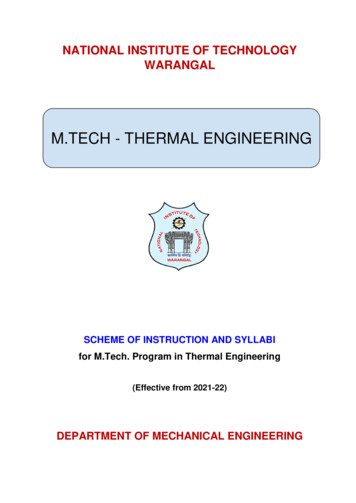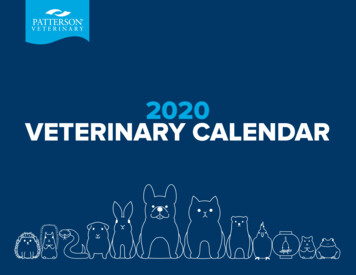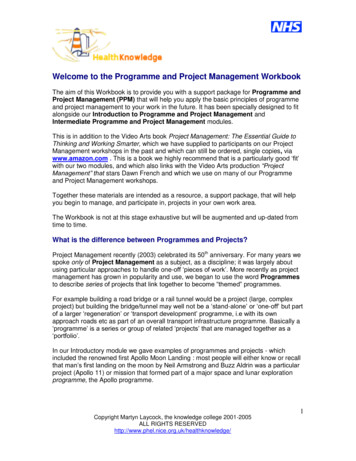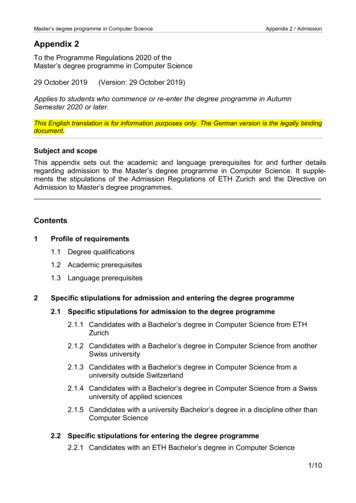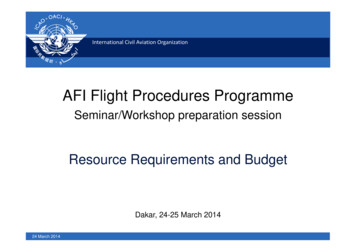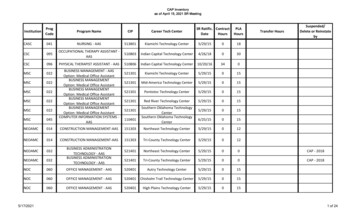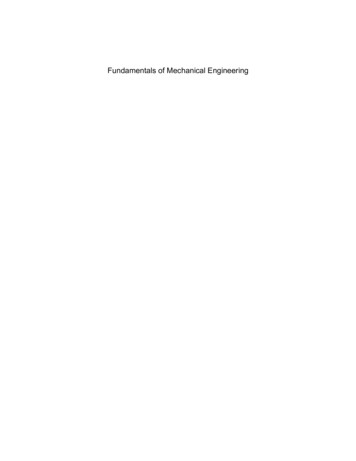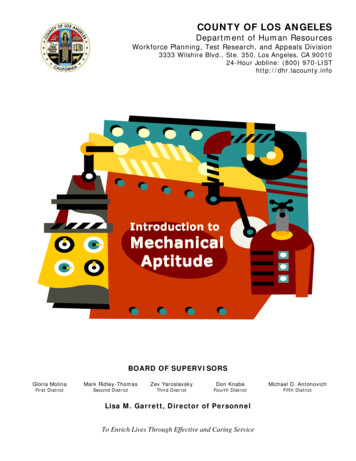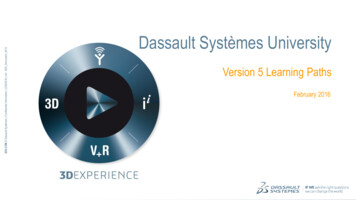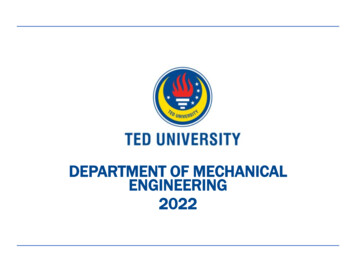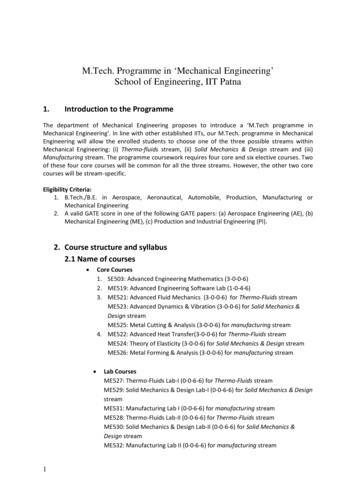
Transcription
M.Tech. Programme in ‘Mechanical Engineering’School of Engineering, IIT Patna1.Introduction to the ProgrammeThe department of Mechanical Engineering proposes to introduce a ‘M.Tech programme inMechanical Engineering’. In line with other established IITs, our M.Tech. programme in MechanicalEngineering will allow the enrolled students to choose one of the three possible streams withinMechanical Engineering: (i) Thermo-fluids stream, (ii) Solid Mechanics & Design stream and (iii)Manufacturing stream. The programme coursework requires four core and six elective courses. Twoof these four core courses will be common for all the three streams. However, the other two corecourses will be stream-specific.Eligibility Criteria:1. B.Tech./B.E. in Aerospace, Aeronautical, Automobile, Production, Manufacturing orMechanical Engineering2. A valid GATE score in one of the following GATE papers: (a) Aerospace Engineering (AE), (b)Mechanical Engineering (ME), (c) Production and Industrial Engineering (PI).2. Course structure and syllabus2.1 Name of courses Core Courses1. SE503: Advanced Engineering Mathematics (3-0-0-6)2. ME519: Advanced Engineering Software Lab (1-0-4-6)3. ME521: Advanced Fluid Mechanics (3-0-0-6) for Thermo-Fluids streamME523: Advanced Dynamics & Vibration (3-0-0-6) for Solid Mechanics &Design streamME525: Metal Cutting & Analysis (3-0-0-6) for manufacturing stream4. ME522: Advanced Heat Transfer(3-0-0-6) for Thermo-Fluids streamME524: Theory of Elasticity (3-0-0-6) for Solid Mechanics & Design streamME526: Metal Forming & Analysis (3-0-0-6) for manufacturing stream 1Lab CoursesME527: Thermo-Fluids Lab-I (0-0-6-6) for Thermo-Fluids streamME529: Solid Mechanics & Design Lab-I (0-0-6-6) for Solid Mechanics & DesignstreamME531: Manufacturing Lab I (0-0-6-6) for manufacturing streamME528: Thermo-Fluids Lab-II (0-0-6-6) for Thermo-Fluids streamME530: Solid Mechanics & Design Lab-II (0-0-6-6) for Solid Mechanics &Design streamME532: Manufacturing Lab II (0-0-6-6) for manufacturing stream
Group AGroup BGroup C Electives I-IIIElective requirements for all three streams will be met by the followingcourses. A student must select three courses from three different groups.ME503: Computational Fluid DynamicsMA507: Nonlinear OptimizationME504: Vehicle Dynamics and Multi-body SystemsME533: Finite Element AnalysisEE501: Control of Mechatronics SystemsPH515: MEMS and NEMSME535: AcousticsME742: Advanced Manufacturing ProcessesME501:Robotics: Advanced Concepts & AnalysisME581: Bio Mechanics and Bio MechatronicsEE503: Signal Processing in Mechatronic SystemsMA511: Large Scale Scientific ComputationME537: Refrigeration and Air-ConditioningElectives IV-VIElective requirements for all three streams will be met by the followingcourses. A student must select three courses from three different groups.ME 542: AerodynamicsME512: Mobile RoboticsGroup A ME534: Wear & Lubrication of Machine ComponentsME506: Emerging Smart Materials for Mechatronics ApplicationsME502: Industrial AutomationME546: Multiphase Flow & Heat TransferGroup B ME554: Rotor DynamicsCE505: Application of probabilistic methods in engineeringMA502: Numerical OptimizationMA504: Computational Differential EquationsMA512: Mathematical ModelingGroup C MA508 Fuzzy Set and Artificial IntelligenceMA514: Design of ExperimentsME541: Turbulent Shear FlowME536: Non-linear Systems Dynamics2
2.2 Course CurriculumSemester 529ME531456783HS513SE507Course TitleAdvanced Engineering MathematicsAdvanced Fluid Dynamics(for Thermo-Fluids Advanced Dynamics & Vibration(for Solid Mechanics and Designstream)Metal Cutting & Analysis(for Manufacturing stream)Thermo Fluids Lab I(for Thermo-Fluids stream)Solid Mechanics and Design Lab I(for Solid Mechanics and Designstream)Manufacturing Lab I(for Manufacturing stream)Elective IElective IIElective IIITechnical CommunicationSeminar-ITotal
Semester IISr.no12CourseNumberME519ME522ME524ME526Course TitleLAdvanced Engineering Software LabAdvanced Heat Transfer(for Thermo-Fluids y of Elasticity(for Solid Mechanics and Designstream)Metal Forming & Analysis(for Manufacturing stream)3ME528ME530ME5324567Thermo Fluids Lab II(for Thermo-Fluids stream)Solid Mechanics and Design Lab II(for Solid Mechanics and Designstream)Manufacturing Lab II(for Manufacturing stream)Elective IVElective VElective VISeminarTotalSE508Semester IIISr. Courseno Number1ME6002ME601Semester IVSr. Courseno Number1ME602Course TitleComprehensive VivaProject-Phase ITotalCourse TitleProject Phase IITotalLT00LTP0PC104050C4545Total credits 44 40 50 45 1794
2.3Detailed Syllabus(Core courses)SE503: Advanced Engineering Mathematics(3-0-0-6)Prerequisite NILLinear Algebra: Matrix algebra; basis, dimension and fundamental subspaces; solvability ofAx b by direct Methods; orthogonality and QR transformation; eigenvalues andeigenvectors, similarity transformation, singular value decomposition, Fourier series, FourierTransformation, FFT. Vector Algebra & Calculus: Basic vector algebra; curves; grad, div,curl; line, surface and volume integral, Green’s theorem, Stokes’s theorem, Gauss-divergencetheorem. Differential Equations: ODE: homogeneous and non-homogeneous equations,Wronskian, Laplace transform, series solutions, Frobenius method, Sturm-Liouvilleproblems, Bessel and Legendre equations, integral transformations; PDE: separation ofvariables and solution by Fourier Series and Transformations, PDE with variable coefficient.Numerical Technique: Numerical integration and differentiation; Methods for solution ofInitial Value Problems, finite difference methods for ODE and PDE; iterative methods:Jacobi, Gauss-Siedel, and successive over-relaxation.Complex Number Theory: Analytic function; Cauchy’s integral theorem; residue integralmethod, conformal mapping.Statistical Methods: Descriptive statistics and data analysis, correlation and regression,probability distribution, analysis of variance, testing of hypothesis.Text Books:1. H. Kreyszig, “Advanced Engineering Mathematics”, Wiley, (2006).2. Gilbert Strang, “Linear Algebra and Its Applications”, 4th edition, Thomson Brooks/Cole,India (2006).3. J. W. Brown and R. V. Churchill, “Complex Variables and Applications”, McGraw-HillCompanies,Inc., New York (2004).4. J. W. Brown and R. V. Churchill, “Fourier Series and Boundary Value Problems”,McGraw-HillCompanies, Inc., New York (2009).5. G. F. Simmons, “Differential Equations with Applications and Historical Notes”, TataMcGraw-Hill Edition, India (2003).6. S. L. Ross, “Differential Equations” 3rd edition, John Wiley & Sons, Inc., India (2004).7. K. S. Rao, “Introduction to Partial Differential Equations”, PHI Learning Pvt. Ltd (2005).8. R. Courant and F. John, “Introduction to Calculus and Analysis, Volume I and II”,Springer-Verlag, New York, Inc. (1989).ME 521 Advanced Fluid Mechanics(3-0-0-6)Concepts of fluids: Definitions of fluids, concept of continuum, different types of fluid, tensoranalysis, governing laws of fluid mechanics in integral form,Reynold’s transport theorem, mass,momentum and energy equations in integral form and their applications, differential fluid flowanalysis, continuity equation, Navier-Stokes equation and exact solutions. Potential flow analysis:Two-dimensional flow in rectangular and polar coordinates, continuity equation and the streamfunction, irrotationality and the velocity potential function, complex potential function, vorticity andcirculation, flow over immersed bodies and D’ Alembert’s paradox, aerofoil theory and itsapplication. Viscous flow analysis: Low Reynold’s number flow, approximation of Navier-stokesequation, approximate solutions of Navier-Stokes equation, Stokes and Oseen flows, hydrodynamictheory of lubrication, Prandtl’s boundary layer equations, Large Reynold’s number flowapproximation, flow instabilities and onset of turbulence. Compressible fluid flow: One dimensional5
isentropic flow, Fanno and Rayleigh flows, choking phenomenon, normal and oblique shocks. Microand nano flow: Physical aspects of micro and nano flows, governing equations, surface tension drivenflows, modeling of micro and nano flows.Text Books:1. White, F.M., Viscous Fluid Flow, McGraw-Hill, New York, 3rd edition 2006.2. Bachelor G. K. An introduction to Fluid Dynamics , Cambridge University Press, 2007.3. Streeter V.L. and Wylie E. B., Fluid Mechanics , Tata McGraw-Hill, Delhi 2001.4. Shames I. H., Mechanics of Fluids , Tata McGraw Hill, Delhi, 4th edition 2003.54. Douglas and Swaffield, Fluid Mechanics , Prentice Hall, 5th edition 2006.6. Yahya S. M., Fundamentals of Compressible Flow , Tata McGraw Hill, Delhi, 3rd edition 2003.7. Karniadakis G., Beskok, A., and Narayan A. Microflows and Nanoflows , Springer, 1st edition2005.8. Journal of Fluid Mechanics,Cambridge University Press.9. Physics of Fluids , , American Institute of Physics.ME523 Advanced Dynamics and Vibration(3-0-0-6)Review of Newtonian mechanics for rigid bodies and system of rigid bodies; coordinatetransformation between two set of axes in relative motion between one another; Euler angles; angularvelocity, angular acceleration, angular momentum etc. in terms of Euler angle parameters; NewtonEuler equations of motion; elementary Lagrangian mechanics: generalized coordinates andconstraints; principle of virtual work; Hamilton’s principle; Lagrange’s equation, generalized forces.Lagrange’s equation with constraints, Lagrange’s multiplier. Nonlinear effects in Dynamics. Reviewof the single DOF system and simple Multi-DOF lumped parameter systems. Equations of motion forfree and forced vibration of distributed parameter systems: axial vibration of a bar, transversevibration of a string, torsional vibration of a shaft, transverse vibration of beams. Boundary-valueproblem and boundary conditions. Differential eigenvalue problem, eigenfunction and natural modes.Orthogonality of eigenfunctions and expansion theorem. Rayleigh quotient. Response to initialconditions and external excitations. Discretization of distributed parameter system: Algebraiceigenvalue problem, eigenvalue and eigenvectors. Introduction to Modal analysis.Text Books:1. H. Baruh, Analytical Dynamics, McGraw-Hill (1999).2. L. Meirovitch, Methods of Analytical Dynamics, Dover Publication, 2010.3. D.T. Greenwood, Principles of Dynamics, Prentice-Hall International, 1988.4. A.A. Shabana, Dynamics of Multibody Systems, 4th Cambridge UniversityPress, 2013.5. L. Meirovitch, Fundamentals of Vibration, McGraw Hill, 2000.6. W.T. Thompson, M.D. Dahleh, C. Padmanabhan, Theory of Vibration withApplication, 5th Ed., Pearson, 2008.7. S.S. Rao, Mechanical Vibration, 4th Ed., Pearson, 2004.8. W. Weaver, Jr., S.P. Timoshenko, D.H. Young, Vibration Problems inEngineering, 5th Ed., John Wiley and Sons, 1990.ME525 Metal Cutting and analysis(3-0-0-6)Single and multipoint tool geometry (ASA, ORS, NRS, MRS), conversion of tool angles;mechanics of chip formation (for ductile and brittle materials): Levy Lodes’ theorem, fracturemechanics; Orthogonal and oblique cutting mechanics; dynamometry (strain gauge, piezoetc); Surface roughness in machining; Thermal aspects of machining; tribology in metalcutting; tool coatings and coating techniques; Economics of machining; Machinability;Cutting fluids: properties, types, application techniques, emissions and its adverse effects;Chip breaker; Recent advances in machining: hard turning, high seed machining, diamondturning, machining of advanced materials, machining with minimum quantity cutting fluids6
and cryogenic fluids; Grinding: mechanics, forces, specific energy, temperature, wheel wearand surface finish; Broaching: mechanics;Text Books:[1] M. C. Shaw, Metal Cutting, Tata McGraw Hill, New Delhi, 2004.[2] M. C. Shaw, Principles of Abrasive Processing, Oxford University Press, 1996.[3]Bhattacharyya, A., Metal cutting: theory and practice, New Central Book, Kolkata, 1984.[4] G. K. Lal, Introduction to Machining Science, New Age International Publishers, 2007.[5] G. Boothroyd and W. A. Knight, Fundamentals of Machining and Machine Tools, CRCTaylor and Francis, 2006.[6] A. Ghosh and A. K. Malik, Manufacturing Science, East West Press, 2010.[7] P. H. Black, Metal Cutting Theory, McGraw Hill, 1961.ME519 Advanced Engineering Software Laboratory(1-0-4-6)CAD/CAM: 2D and 3D geometric transformation, Composite Transformation, Projections; Curves:Cubic, Bezier, Splines; Surfaces: Quadric, Coons patch, Super Quadric, Bezier, B-Splines. Processplanning, CL data generation, Automatic CNC code generation.FEM: Solid model creation, different types of elements, chunking of model, meshing, mesh quality,different kinds of analysis : static, dynamic, transient, thermal, electro-magnetic, acoustics, substructuring and condensation, Error and convergence.Non-linear static and dynamic analysis, contact analysis, multi-physics problem, rigid body analysisof flexible element.CFD: Different types of CFD techniques, various stages of CFD techniques (i) pre processor:governing equations, boundary conditions, grid generation, different discretization techniques (ii)processor: solution schemes, different solvers (iii) post-processing: analysis of results, validation, gridindependent studies etc. Developing codes using commercial/open source software for solving fewproblems of laminar and turbulent flow with heat transfer applications.Engineering softwares related to CAD/CAM, FEM, CFD, with both GUI and script like languages,are to be used for laboratory assignments.Text Books:1. D. F. Rogers and J. A. Adams, “Mathematical Elements for Computer Ggraphics”, McGrawHill, 19902. M. Groover and E. Zimmers, “CAD/CAM: Computer-Aided Design and Manufacturing”,Pearson Education, 2009.3. A. Saxena and B. Sahay, “Computer Aided Engineering Design”, Springer, 2007.4. J. N. Reddy, “An Introduction to Finite Element Methods”, 3rd Ed., Tata McGraw-Hill, 2005.5. J. Fish, and T. Belytschko, “A First Course in Finite Elements”, 1st Ed., John Wiley and Sons,2007.6. J. D. Anderson, “Computational Fluid Dynamics”, McGraw-Hill Inc. (1995).7. H. K. Versteeg and W. Malalaskera, “An Introduction to Computational Fluid Dynamics”,Dorling Kindersley (India) Pvt. Ltd. (2008).8. S. Biringen and C Chow, An Introduction to Computational Fluid Mechanics by ExampleME522 Advanced Heat Transfer(3-0-0-6)Conduction: Equations and boundary conduction in different coordinate systems; AnalyticalSolutions: separation of variables, Laplace Transform, Duhamel’s theorem: Non-impulse initialconditions; Numerical Methods: Finite difference and flux conservation; Interfacial heat transfer.Convection: Conservation equations and boundary conditions; Heat transfer in laminar developed anddeveloping boundary layers: duct flows and external flows, analytical and approximate solutions,effects of boundary conditions; Heat transfer in turbulent boundary layers and turbulent duct flows;7
Laminar and turbulent free convection, jets, plumes and thermal wakes, phase change. Radiation:Intensity, radiosity, irradiance, view factor geometry and algebra; formulations for black and non–black surfaces, spectrally–selective surfaces (solar collectors); Monte Carlo methods for radiationexchange; The radiative transfer equation, extinction and scattering properties of gases and aerosols,overview of solution methods and applications. Interaction between conduction, convection andradiation: Coupled problems; Examples in manufacturing and electronic cooling applications; Microchannels and micro fins.Text Books:[1] M N Ozisik, Heat Conduction, 2nd ed, John Wiley & Sons, 1993[2] Kakaç, S., Yener, Y., Heat Conduction, 3rd edition, Taylor & Francis, 1993.[3] F P Incropera and D P Dewitt, Introduction to Heat Transfer, 3rd ed, John Wiley & Sons, 1996[4] W. M. Kays and E. M. Crawford, Convective Heat and Mass Transfer, Mc Graw Hill,1993.[5] Adrian Bejan, Convective Heat Transfer, John Wiley and Sons, 1995.[6] M F Modest, Radiative Heat Transfer, McGraw-Hill, 1993[7] R Siegel and J R Howell, Thermal Radiation Heat Transfer, 3rd ed, Taylor & Francis, 1992ME524 Theory of Elasticity(3-0-0-6)Stress and strain tensors, equations of equilibrium and compatibility in rectangular and curvilinearcoordinates, Cauchy’s formula, stress transformation, principal stresses, Lame’s stress ellipsoid,Cauchy stress quadratic, octahedral stress, stress-strain relations, basic equations of elasticity,Boundary value problem, Uniqueness of solutions, Torsion of non-circular sections, St. Venant’stheory of torsion, Scalar and Vector potentials, Strain potentials. Plane state of stress and strain,Airy’s stress function for problems, Representation of biharmonic function using complex variables,Kolosoff-Mushkelishvili method. Thermal stress, Applications to problems of curved beam, thickcylinder and rotating disc, stress concentration. Introduction to numerical methods in elasticity.Contact problems, energy and variational principles Theory of Elasticity:Text Books:1. S.P. Timoshenko and J.N. Goodier, Theory of Elasticity, Tata McGraw-Hill, 2010.2. L.S. Srinath, Advanced Solid Mechanics, Tata McGraw-Hill, 2002.3. I.S. Sokolnikoff, Mathematical Theory of Elasticity, 2nd Ed., McGraw-Hill, 1956.4. Y.C. Fung, Foundations of Solid Mechanics, Prentice-Hall, 1965.ME526 Metal Forming and Analysis(3-0-0-6)Stress-strain relations in elastic and plastic deformations, Yield criteria for ductile metals,Work hardening and Anisotropy in yielding, Flow curves, Elements of theory of plasticity,Formulation of plastic deformation problems, Application of theory of plasticity for solvingmetal forming problems using slab method, Upper and lower bound methods, slip line fieldtheory, Effects of temperature and strain rate in metal working, Friction and lubrication incold and hot working, Technology and Analysis of important metal forming processes–Forging, Rolling, Extrusion, Wire Drawing, Sheet metal forming processes like Deepdrawing, Stretch forming, Bending, Introduction to Finite Element Analysis of metal formingprocesses.Texts Books:[1] R.H Wagoner, Metal Forming Analysis, Cambridge University Press[2] G. W. Rowe, Principles of Industrial Metal working processes, CBS publishers andDistributors[3] B. L. Juneja, Fundamentals of Metal forming processes, New age international publishers8
[4] A. Ghosh and A. K. Malik, Manufacturing Science, East West Press[5] J. Chakrabarty, Theory of Plasticity, McGraw Hill, 1998.[6] Dieter, Mechanical Metallurgy, McGraw Hill. Inc[7] By William F. Hosford, Robert M. Caddell, Metal Forming: Mechanics and Metallurgy,Cambridge University PressME503 Computational Fluid Dynamics(3-0-0-6)Concept of Computational Fluid Dynamics: Different techniques of solving fluid dynamicsproblems, their merits and demerits, governing equations of fluid dynamics and boundary conditions,classification of partial differential equations and their physical behavior, Navier-Stokes equations forNewtonian fluid flow, computational fluid dynamics (CFD) techniques, different steps in CFDtechniques, criteria and essentialities of good CFD techniques.Finite Difference Method (FDM):Application of FDM to model problems, steady and unsteadyproblems, implicit and explicit approaches, errors and stability analysis, direct and iterative solvers.Finite Volume Method (FVM): FVM for diffusion, convection-diffusion problem, differentdiscretization schemes, FVM for unsteady problems.Prediction of Viscous Flows: Pressure Poisson and pressure correction methods for solving NavierStokes equation, SIMPLE family FVM for solving Navier-Stokes equation, modelling turbulence.CFD for Complex Geometry:Structured and unstructured, uniform and non-uniform grids, differenttechniques of grid generations, curvilinear grid and transformed equations.Lattice Boltzman and Molecular Dynamics: Boltzman equation, Lattice Boltzman equation, LatticeBoltzman methods for turbulence and multiphase flows, Molecular interaction, potential and forcecalculation, introduction to Molecular Dynamics algorithms.Text Books:1. J. D. Anderson, “Computational Fluid Dynamics”, McGraw-Hill Inc. (1995).2. S. V. Patankar, “Numerical Heat Transfer and Fluid Flow”, Hemisphere Pub. (1980).3. K. Muralidhar, and T. Sundarajan, “Computational Fluid Flow and Heat Transfer”,Narosa (2003).4. D. A. Anderson, J. C. Tannehill and R. H. Pletcher, “Computational Fluid Mechanicsand Heat Transfer”, Hemisphere Pub. (1984).5. M. Peric and J. H. Ferziger, “Computational Methods for Fluid Dynamics”, Springer(2001).6. H. K. Versteeg and W. Malalaskera, “An Introduction to Computational FluidDynamics”, Dorling Kindersley (India) Pvt. Ltd. (2008).7. C. Hirsch, “Numerical Computation of Internal and External Flows”, ButterworthHeinemann, (2007).8. J. M. Jaile, “Molecular Dynamics Simulation: Elementary Methods”, WilleyProfessional, 1997.9. A. A. Mohamad, “Lattice Boltzman Method: Fundamentals and EngineeringApplications withComputer Codes”, Springer (2011).ME537 Refrigeration and Air conditioningPre-requisites: NilRefrigeration9(3-0-0-6)
Refrigeration systems: Vapour compression, vapour absorption and air refrigeration system, Thermoelectric refrigeration, Cryogenics.Refrigeration Hardware: Refrigerant compressors, refrigerant condensers, refrigerant evaporators,receiver, expansion devices, filter-drier, moisture indicator etc.Refrigeration Controls: HP/LP cut-out, Solenoid valve, evaporator pressure regulator, Accumulators,Suction pressure regulator.Capacity control techniques: Hot gas by-pass scheme, Cylinder loading scheme, suction gas throttlingschemeRefrigerants: Classification and nomenclature, desirable properties of refrigerants, commonrefrigerants, environmental issues-Ozone depletion and global warmingAlternative refrigerants: low GWP and zero ODP newer refrigerants.Applications of Refrigeration: Industrial refrigeration, Transport refrigeration, food preservation (coldstorage)Air-conditioningReview of Basic psychrometry: Sensible cooling/heating processes, humidification /dehumidificationprocesses on psychrometric chart etc.Classification of air-conditioners: unitary systems (Window type/self-contained/single-package unit),split-unit and Central air conditioning systemCooling/Heating load calculations: Transmission load, Solar heat gain, Occupancy load, Equipmentload, Infiltration and ventilation load.Duct Design: Design considerations and proceduresAir Conditioning controls: basic elements, types of control systemsTexts and References:1. Dossat R.J., 2008. Principles of Refrigeration, Pearson Education (Singapore) Pte. Ltd.2. Stoecker W., 1982. Refrigeration and Air Conditioning, Tata McGraw-Hill PublishingCompany Limited, New Delhi.3. Khan, M.K., 2012, Chapter 15: Refrigeration, Air Conditioning and Cold Storage, Handbookof Food Process Design, pp. 381-429., Wiley-Blackwell (UK).4. Arora C.P., 2005. Refrigeration and Air Conditioning, Tata McGraw-Hill PublishingCompany Limited, New Delhi.5. Ameen A., 2006. Refrigeration and Air Conditioning, Prentice Hall of India Private Limited,New Delhi.6. American Society of Heating Refrigerating and Air Conditioning Engineers Inc, 2013ASHRAE Handbook- Refrigeration Fundamentals.7. American Society of Heating Refrigerating and Air Conditioning Engineers Inc, 2011ASHRAE Handbook- HVAC Applications.ME535 Acoustics(3-0-0-6)Acoustics: Mathematical basis for Acoustics- PDE, Vectors, divergence (Greens) theorem, Stokestheorem, Signal processing. Development of Wave equation, Helmholtz equation. Acoustic waveequation- Plane waves, Acoustic -Power, Intensity & measurement. Transmission, Absorption andattenuation of sound waves in fluids, Spherical Waves, monopole, dipole, quadropole and pistonradiator. Radiation and Reception of Acoustic waves. Active sound control Pipes, Cavities,Waveguides, Resonators, Filters and Ducts-Plane Waves, energy dissipation, finite amplitudes andtransmission phenomena, horn radiator, mufflers, silencers. Noise, signal detection, hearings andSpeech-Noise spectrum and band level, combining band levels and Tones, Detecting signal in noise,Detection threshold, Ear-Thresholds, Equal loudness level contours, Critical bandwidth, MaskingLoudness level, Pitch and frequency. Environmental Acoustics- weighted Sound levels, Speechinterference, Criteria for Community noise Highway noise, Aircraft noise rating, Hearing loss,10
Legislations for Noise control. Architectural acoustics, Reverberation time, Sound Absorptionmaterials, Direct and Reverberant Live rooms, Acoustic factors in design Transductiontransducers/transmitters- anti reciprocal, reciprocal. Loudspeakers, Microphones. Introduction toUnderwater Acoustics.Text Books:[1] Fundamental of Physical Acoustics, David T Black Stock, John Wiley & Sons, Inc[2] Noise and Vibration Control Engineering: Principles and Applications Leo L. Beranek , JohnWiley & Sons, Inc[3] Handbook of Noise and Vibration Control edited by Malcolm J. Crocker, John Wiley & Sons,Inc., New York, 2007ME536 Nonlinear System Dynamics(3-0-0-6)Introduction to Nonlinear Dynamical System: Linear vs. nonlinear behavior, Classification ofnonlinear Systems, Examples of structural, fluid-mechanical and chemical/biological systems,Existence and uniqueness of solutions.First-order nonlinear systems: Autonomous systems: Equilibrium points, linear systems, invariantsets, linearization, phase diagrams and velocity fields, behavior dependence on parameters,bifurcations of equilibria (saddle-node, pitchfork and transcritical), implicit function theorem.Nonautonomous systems.Second-order nonlinear conservative/nonconservative systems: Phase plane analysis, equilibriumpoints, linearization, stability, periodic orbits and saddle points, potential function and phase portrait,parameter-dependent conservative systems, local bifurcations, examples of global bifurcations, effectof dissipative forces.First-order system in the plane: General phase plane analysis, linearization, general solution for linearsystems, classification of equilibrium points, limit cycles, Bendixon's criterion and Poincare Bendixontheorem. Point mapping techniques, exact transformations, and Poincare mappings.One-dimensional linear and nonlinear mappings: Fixed points, linearization, stability, parameterdependent mappings, bifurcations.Perturbation and other approximate methods: Introduction to regular and singular perturbationexpansions through algebraic and transcendental equations; roots of equations and dependence onparameters. Perturbation method for free oscillations, secular terms, frequency dependence onresponse, Poincare-Lindstedt technique for periodic solutions, Harmonic balance and Fourier seriesfor periodic solutions. Averaging methods, amplitude and frequency estimates, slowly varyingamplitude and phase ideas, self-excited oscillations. Multiple time-scale techniques. Forcedoscillations, concept of a resonance, oscillations far from resonance, near resonances and strong andweak excitations, response near primary resonance, softening and hardening nonlinearities, Duffing'sequation and primary and secondary resonances, forced response of self excited systems nearresonance, frequency locking and entrainment.General linear systems with constant and periodic coefficients: Concepts of stability (Lyapunov,Poincare, etc.), stability by linearization, boundedness of solutions, Mathieu's equation, transitioncurves and periodic solutions for Mathieu-Duffing system.Relaxation oscillations: The van der Pol oscillator.Multi degree of freedom systems: Examples, various types of resonances – external, internal, andcombination, etc., response prediction using methods of averaging and multiple scales.Some more on bifurcations, structural stability and chaos.Experimental Demonstration: String ballooning motion. Fun with Cantilever beam of largedeformation and other developed models. Electronic Circuit building. Numerical computation withMatlab/ Mathematica.Text Books:11
1. Jordan, D. W. and Smith, P.: Nonlinear Ordinary Differential Equations, 3rd Edition,Clarendon Press, Oxford, 1999 ed.2. Nayfeh, A. H. and Mook, D. T.: Nonlinear Oscillations, Wiley Interscience, New York., 1979ed.3. Nayfeh, A. H and Balachandran, B. : Applied Nonlinear Dynamics: Analytical,Computational and Experimental Methods, Wiley, 2008 ed.4. Strogatz, S. H. : Nonlinear Dynamics And Chaos: With Applications To Physics, Biology,Chemistry, And Engineering, Westview Press, 2001 ed.5. Ogorzalek Maciej J.:Chaos and Complexity in Nonlinear Electronic Circuits, World ScientificSeries on Nonlinear Science Series A, 1997 ed.ME534 Wear and Lubrication of Machine components(3-0-0-6)Course objectives: Surface failure due to rubbing is a critical problem that affects the life andreliability of modern machinery. The knowledge of surface interaction is interdisciplinary andessential to design for life and reliability and also enable innovation in electromechanical and materialengineering design. The course focuses on theories of friction, wear, contact and lubrication,approaches to model basic tribological elements/systems, and methods to simulate tribologicalprocesses. Course content: Definition of Tribology, Significance for Maintenance and Reliability ofmachines, Terotechnology. Surface- roughness, materials, mechanics of surface/solid contactsFriction Laws of Friction, Mechanisms of Friction, Friction Space, Stiction, Stick Slip, SurfaceTemperature, surface energy, micro and nano scale viewsWear Adhesive Wear, Delamination Wear,Fretting Wear, Abrasive Wear, Erosive Wear, Corrosive Wear, Mild and Severe Oxidational y,Rotary,Rolling/slidingHeathcoteLubrication- Regimes, Boundary Lubrication, Solid-Film Lubrication, Mixed Lubrication,Hydrodynamic Lubrication, Hydrostatic Lubrication, EHL, Lubrication in vacuum, Bearings- Rollingelement, Step, Pad, Journ
2. A valid GATE score in one of the following GATE papers: (a) Aerospace Engineering (AE), (b) Mechanical Engineering (ME), (c) Production and Industrial Engineering (PI). 2. Course structure and syllabus 2.1 Name of courses Core Courses 1. SE503: Advanced Engineering Mathematics (3-0-0-6) 2. ME519: Advanced Engineering Software Lab (1-0-4 .
